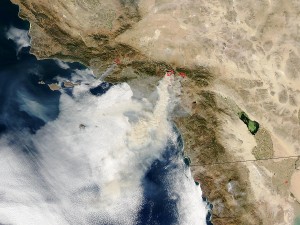15 December 2010
Where there’s smoke, there’s fire…and soot
Posted by mohi

This satellite image taken on October 25, 2003 shows the spreading smoke from multiple wildfires (red dots) around Los Angeles. Image courtesy of NASA.
I moved to Southern California in 2002 to attend college, and I distinctly remember the fires that burned through the San Bernardino Mountains in October of my sophomore year. From my dorm room window at night I could see the hills aglow with flames. During the day, the sky took on an eerie, apocalyptic glow, and the sun shone sunset red, even at mid-day. A haze filled the air, and soot blanketed everything from cars to clothes.
I was reminded of my wildfire experience during session A22A Biomass Burning: New Findings and Analyses From Multiple Perspectives II, as Hans Moosmüller, from the Desert Research Institute in Nevada, talked soot. Understanding the particulate matter that wildfires produce is key to understanding the fires’ larger effects on the climate.
One way to characterize soot is by color. Soot can be black or white or somewhere in between. Smaller particles tend toward the darker side of the color scale, while larger particles are lighter. And as everyone who has touched the hood of a black car on a sunny day knows, darker colors absorb more light.
Whether a wildfire produces black or white soot depends on the conditions of the blaze, Moosmüller explained. Flaming fire, which usually occurs when fire encounters fresh fuel in hot, dry conditions, tends to produce black soot (a.k.a. black carbon). The smoldering fire that lingers after the flames have moved on to new fuel, however, generally creates white soot (a.k.a. organic carbon). In wildfires, the flame front of a fire will generate a small percentage of black soot (under 20% ), while the smoldering remains release a large quantity of white soot.
Moosmüller added that predicting the overall effect of soot color on climate is not a simple matter. While completely black soot would have a warming effect and completely white soot would have a cooling effect, if the soot is a combination of the two, a lot depends on the color of the Earth that the soot is blanketing. Clouds of grey soot floating out over a dark ocean reflect more light than the ocean by itself–a cooling effect. But put grey soot on a white glacier and the ice will soon start to melt.
Initial analyses suggest that soot from open wildfires do not contribute to a greenhouse warming effect. The soot poses other dangers, however, including health hazards. And that brings back another memory from October of 2003—my fellow students came to class wearing surgical masks.
–Catherine Meyers is a science communication graduate student at UC Santa Cruz.










 GeoSpace is a blog on Earth and space science, managed by AGU’s Public Information staff. The blog features posts by AGU writers and guest contributors on all sorts of relevant science topics, but with a focus on new research and geo and space sciences-related stories that are currently in the news.
GeoSpace is a blog on Earth and space science, managed by AGU’s Public Information staff. The blog features posts by AGU writers and guest contributors on all sorts of relevant science topics, but with a focus on new research and geo and space sciences-related stories that are currently in the news.